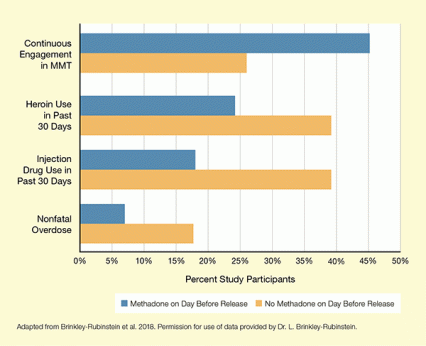This study reported:
- Prisoners who received methadone maintenance treatment (MMT) during incarceration were more likely than prisoners who did not receive MMT to engage in the treatment after being released.
- Those who received methadone during incarceration also reported less heroin use and had a lower risk of nonfatal overdose after being released.

Many people who are incarcerated have opioid use disorder (OUD). Evidence suggests that methadone maintenance treatment (MMT) during incarceration can reduce prisoners’ risks of overdose and other short-term adverse outcomes after release, but few jails and prisons in the United States offer it. Dr. Lauren Brinkley-Rubinstein from the University of North Carolina School of Medicine and her colleagues recently reported that continued MMT during incarceration significantly improved engagement in treatment for OUD and reduced overdose risk for at least 12 months after release. "Hopefully, the results of this study will help persuade correctional administrators to implement medication-assisted treatment programs in their facilities," says Dr. Brinkley-Rubinstein.
The study included 179 individuals as they began incarceration at the Rhode Island Department of Corrections. All had been receiving MMT when they entered jail or prison, and all were to be incarcerated for 1 week to 6 months. About half of the participants received continued MMT; the others received the correctional system’s standard care of forced, tapered withdrawal from methadone (see Figure 1). The researchers followed the participants for 1 year after release, assessing continued MMT and other treatment participation as well as various drug-related outcomes.
At 12 months after release, participants in the MMT group were slightly more likely to have resumed community MMT and to remain continuously engaged than those in the forced-withdrawal group. They also were slightly less likely to be re-incarcerated, present to an emergency department, use heroin, or report injection drug use. However, some participants with shorter incarceration times who were assigned to the forced-withdrawal group were still receiving methadone at the time of release, which may have narrowed differences between the groups.
See full text description at end of article.
The investigators therefore performed a second analysis comparing outcomes between the 128 participants who received methadone on the day before release and the 51 participants who did not. This analysis demonstrated significant differences between the two groups at 12 months (see Figure 2). Compared with participants who were off MMT, those who received methadone on the day before release were:
- Less likely to use heroin or other injectable drugs
- Less likely to experience a nonfatal overdose
- More likely to have continued MMT in the community post-release
Even among participants who received methadone the day before release, only about 45 percent continued MMT long term, suggesting that other obstacles may have prevented treatment access in the community post-incarceration. Nevertheless, Dr. Brinkley-Rubinstein is optimistic about the potential of MMT during incarceration. She says, "This study provides even more evidence to the growing body of knowledge about the short-term and long-term positive impact of access to medication-assisted treatment during prison and jail."
This study was supported by NIH grants DA035692, DA037190, DA029201, and DA022112.
- Text Description of Figure 2
-
The graphic shows the effects of methadone maintenance treatment (MMT) during incarceration on various drug-related outcomes when interviewed 12 months post-incarceration. The horizontal x-axis shows the percentage of study participants reporting a specific outcome on a scale from 0 percent to 50 percent in 5-percent increments. The vertical y-axis shows the outcomes investigated. Blue bars represent participants who received MMT on the last day before release and the orange bars represent participants who did not receive MMT on the last day before release.
The top pair of bars represents participants with continuous engagement in MMT after release. The percentage was about 45 percent among those who received MMT on the day before release and about 26 percent among those who did not receive MMT on the day before release.
The second pair of bars from the top represents participants who had used heroin in the past 30 days before the interview. The percentage was about 24 percent among those who received MMT on the day before release and about 39 percent among those who did not receive MMT on the day before release.
The third pair of bars from the top represents participants who had used injection drugs in the past 30 days before the interview. The percentage was about 18 percent among those who received MMT on the day before release, and about 39 percent among those who did not receive MMT on the day before release.
The bottom pair of bars represents participants who had experienced a nonfatal overdose in the 12 months since their release. The percentage was about 7 percent among those who received MMT on the day before release, and about 18 percent among those who did not receive MMT on the day before release.
Source:
- Brinkley-Rubinstein, L., McKenzie, M., Macmadu, A., et al. A randomized, open-label trail of methadone continuation versus forced withdrawal in a combined U.S. prison and jail: findings at 12 months post-release. Drug and Alcohol Dependence. 184:57-63, 2018.

